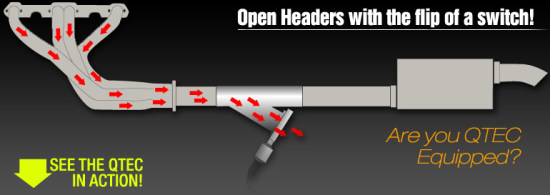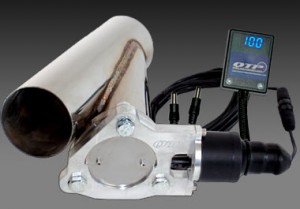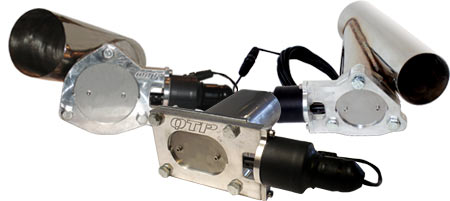Do QTP Electric Exhaust Cutouts Live Up To The Hype?
Benjamin | Jun 16, 2010 | Comments 16
Power versus noise – it’s a common dilemma facing anyone considering a Toyota Tundra exhaust system. If you’re interested in additional horsepower for towing, hauling, or off-roading, a free-flowing exhaust is one of the best performance investments you can make. However, some of the most aggressive “free-flowing” exhaust systems can transform your truck’s engine note from a tasteful purr to a raucous thunderclap that is both irritating to your neighbors and headache-inducing at highway speeds.
One solution that appeals to truck owners who only require additional exhaust flow in specific situations is to install an exhaust system cutout. A cutout is essentially a Y-pipe that is welded inline with your existing exhaust piping. At its most basic, a cutout is designed so that the portion of the Y-pipe that vents to the atmosphere can be opened in order to divert exhaust gases and bypass a vehicle’s mufflers and resonators. In theory, this creates an exhaust system whose only restrictions are the catalytic converters, which increases flow, reduces back pressure and generates more power.
Quick Time Performance has an electric cutout system that is a little bit fancier than the design described above. While the QTP setup also consists of a Y-pipe, it additionally provides full remote electronic control from inside the cabin over how much the Y-pipe is opened. The system can be set to open fully or in small increments, which according to the company allows you to vary your truck’s exhaust backpressure to suit your application. At the touch of a button, any Tundra equipped with Quick Time Performance cutouts can go from a mild to wild exhaust in a few seconds.
There are obvious advantages to using an electric exhaust cutout. If you are someone who frequently drives off-road where the amount of noise your truck produces is really only limited by your own personal tolerance, then the appeal of a QTP cutout system is obvious. The same can be said for anyone who takes their truck to the drag strip, where opening up the exhaust for a quick 14 second pass down the quarter mile could also be beneficial.
That being said, there are a few issues with exhaust cutouts that should be kept in mind. Although Quick Time Performance claims that the reduced backpressure provided by an open cutout actually improves fuel mileage, this claim isn’t backed up by any real-world testing. In fact, it would not be surprising if the reason that trucks running open cutouts used less fuel is because their drivers go easier on the gas pedal in order to save their hearing – and their sanity.
Perhaps more importantly, for anyone who lives in a northern climate where road salt is a fact of life, cutouts remain extremely vulnerable to corrosion. While portions of the QTP setup are made out of aluminum, there are still a number of steel components – including the butterfly plate – that could rust up and eventually seize in either the open or closed position.
Quick Time Performance cutouts are a viable solution for those who need to occasionally bypass their exhaust system for trail driving or drag racing, and who are aware of what they will be getting into in terms of noise and potential corrosion risks. However, few outside of this particular group of Toyota Tundra owners will actually benefit enough from installing exhaust cutouts to outweigh the noise, complexity, and corrosion risks that go along with them.
Search terms people used to find this page:
- tundraheadquarters
Filed Under: Tundra Exhaust





I wonder how the loss of back pressure affects the engine at lower speeds as the cylinders are not kept as full. I would bet drivability of the truck is affected. Stick with a nice Borla or flowmaster exhaust: quieter and better for your truck.
when we were teens, our cars had a manual version of this. we would head out to the “strip” out in the country, unbolt the the blocker plate and basically run open exhaust while racing our buddies. VERY LOUD!
I love the rumbling sound of flowmasters and such, but it has become a recent thing around here to have obnoxiously extremely loud pipes. Everything from cars to trucks and especially those lil’ cars that sound like wide open motorcycles are getting too loud. Oh, lets not forget loud pipes on motorcycles coming through my neighborhood at 3am. Our local police are about to crack down on excessively loud stereos and pipes within the city limits. Please don’t get me wrong, i love loud pipes and loud music, but we also have to respect the rights of others. Sorry for veering off the subject.
I can see this as a benefit to turbochared or superchared engines, but naturally aspirated engines would lose low end torque due to loss of backpressure. On the other hand will gain some mid-range and top-end power on N/A engines. Seen it numerous times on dyno’s, not with QTP cut outs per se, but exhaust systems unbolted from headers.
Im guessing this isnt very street legal, is it?…I’ve thought about straight piping before instead of buying and installing a flowmaster, but ive heard that in texas a straight piped truck may not pass state inspections 🙁
Brian J – You make a great point – at low RPMs, a cut-out probably doesn’t help your truck. At the track? Maybe.
Danny – I’m with you. Loud motorcycles really annoy me. Loud V8’s? Not as much. This is one of the many reasons I’m a hypocrite. 🙂
TC8 – I think that QTP tried to compensate for the loss of back pressure by making the opening adjustable. It doesn’t have to be opened all the way…but I agree. It’s perfectly feasible to build a muffled exhaust system that doesn’t impact performance in a measurable way.
Jr. – No, but a lot of the motorcycles and cars I see around definitely aren’t street legal, and no one seems to be doing anything. As for passing an inspection, you would know better than I, but it sounds right to me.
Must be trying to imitate a HD!
You know that 80% of all HD’s are still on the road don’t you? The other 20% made it home! Now why would tundra owners want to imitate HD?
When partially open (mixed flow) do you hear sound emmitting from both exit points (cut outs & exhaust sound?)
I wonder if it’s a combo of sounds if it’s set for anything less then 50%?
Or because mufflers do what their supposed to do, the slightest opening of the butterfly kills anything trying to get further down stream.
I would imagine that it depends on the location of the cut outs being placed directly inline of the oncoming gases.
Stuart
Stuart – I don’t know, but you’re asking some good questions. I think the biggest advantage of this system is that it allows you to run straight pipes at the track. If you race your car on the weekends, this system is for you. Otherwise, I think a regular old performance exhaust system makes more sense.
I love the idea of the partial on or off, but even better is when you only have a few seconds at most to make a decision on turning it up a notch.
I don’t any vids on the controllers function and ease of use.
It seems like a bulky item to stash nearby.
I would love a dash button or two to just tap, instead of reaching for something when the need arises.
Stuart
Stuart – I didn’t see a video that demonstrated the controller either – only I did see an electronic version of the controller. Maybe that would give you the push-button function.
I’ll be at SEMA next month. If these guys are there and they have a demo vehicle, I’ll shoot some video.
I’m in the US next week for two weeks and I’ll probably order a pair and take them back to OZ.
There are so many makers using the bi system exhausts to give legal requirements and enthusiasts ears some pleasure.
I would hope that there’s a chance to tie the cars electrics into the controller (or future versions) and set a function.
For what I’m looking at 2003 BMW M5, I’d love to see it start to opening fully at say 3k/4k
Now you can be Mr silent when needed and hit the real loud pedal once in that zone.
I’ve got a friend that might be going to SEMA as well, so I’ll ask him to keep an eye out for QTP.
Another thing, I wonder if you guys have done any tests on the type of sounds the twin system makes dependent on what part of the flow it’s located?
I would say the best sound would be further down stream, near the headers would be pretty raw and unbearable?
I’m thinking for me right next to the entry point to the exhaust would be good to hide them (cops and roads people). and keep the rawness.
Sorry for the long reply.
Stuart
Stuart – Interesting idea about the difference in sound based on where the cut-outs are placed. My guess? Probably not too much of an impact regardless of location…but it’s only a guess.
Back pressure is a myth
READ FULL ARTICLE FOR ENTIRE UNDERSTANDING OF WHAT IS SAID
“There is a common misconception that engines need backpressure in order to run properly, generate low end torque, etc. That is simply untrue. Backpressure is a bad thing. Always. Take a look at a top fuel dragster…how much backpressure do you think those zoomie headers make? Very little, and those engines produce 6500 hp.”
…
read the rest here: http://www.dsmtuners.com/forum.....ssure.html
Matt,
Thanks for the depth of the comment, very good points.
-Tim
Matt – Thanks for the article…only please be sure to post the link instead in the future.
While I’m not sure if you wrote that original article, here’s what I have to say:
The author is absolutely correct when they say that reducing pipe size restricts flow. However, flow requirements vary by RPM. At high RPMs, the ideal pipe size is substantially larger than the ideal pipe size at idle. What pipe size do you use? Go too big, and you have no scavenging effect at low RPMs, and this hammers low-end torque. Go too small on the pipe and you lose top-end performance.
The solution? A somewhat restrictive muffler and a large exhaust pipe. At lower RPMs, where velocity is low, the muffler is more of an impediment to flow than it is at higher velocities. This way, the pipe is effectively smaller at low RPMs, and gets “bigger” as RPMs increase.
Therefore, a muffler must create backpressure for a typical exhaust system to function properly.